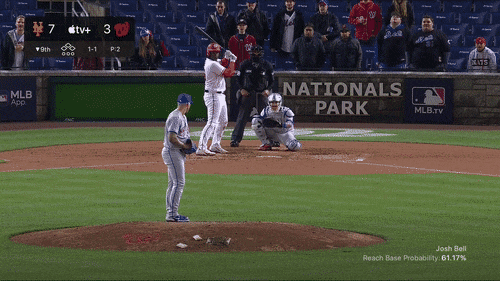We’re barely a week into the new season, but that doesn’t mean it’s too early to get excited about pitchers flashing their new stuff, even if we’ve only got an inning or two’s worth of pitches. One of the fun parts of the calendar flipping to March and April is watching pitchers for the first time in six months and seeing who’s flashing something new. In much of the country, throwing harder in April is far from easy—take it from a Chicagoan. That being the case, here are five otherwise unremarkable—or at least, previously unremarkable—relievers who might be on an upward trajectory even at this early juncture based on some whiffs of a velocity.
Sean Reid-Foley, RHP, New York Mets
2021 four-seam velocity: 93.7 mph
2022 four-seam velocity: 95.8 mph
The bad news? Reid-Foley was pretty bad in 2021, and the 2022 results have been a mixed back, failing to record a strikeout even in a scoreless inning to open the season, and allowing two runs in his next two-thirds inning of action on Monday. The good news? Reid-Foley flashed excellent stuff out of the rotation for much of his minor league career, putting up 10.2 K/9 below the MLB level. And as bad as his 5.12 major league ERA was last year, he still managed to strike out 26 hitters in 20 innings. There are few circumstances where an extra two ticks of velo aren’t helpful, and Reid-Foley’s strikeout baseline is high enough that it could make him a valuable part of New York’s bullpen.
There’s more velocity-related good news for Reid-Foley in particular. His changeup has been far more effective than his slider to this point in his big league career, and to this point in the 2022 season, he’s throwing the changeup more than ever (11 out of 31 pitches), and critically, he’s adjusted it to drop more than 300 RPM and almost a full mph of velocity, creating an extra 2-3 mph of separation from the fastball and a pleasing swing-and-miss aesthetic when he hits the right spot:

Jorge López, RHP, Baltimore Orioles
2021 sinker velocity: 95.3 mph
2022 sinker velocity: 98.1 mph
López has appeared in more than 100 MLB games, 58 of them starts, to the tune of a 6.05 ERA. He’s already walked four and allowed two runs in two and a third innings this year. He’s spent most of his career giving up runs in rather predictable fashion, as often happens with a low-90s fastball that in no way made up for a lack of effective secondary pitches. My first introduction to López was attendance at this 2019 Yoán Moncada slugfest:
Not good! He’s still giving up runs in 2022, but now he’s giving up runs while throwing like this:
Excuse me, what? The Orioles haven’t had any pitching to boast of since the Obama administration, but one would hope they might be able to do something with a pop-up arm like this, in spite of what history says.
Ryan Helsley, RHP, St. Louis Cardinals
2021 four-seam velocity: 97.4 mph
2022 four-seam velocity: 99.4 mph
Hey, look, someone with actual big league success under their belt! Helsley entered 2022 having already established himself as a contributor in the Cardinals ever-deep bullpen with a 4.03 ERA in 87 games between 2019 and 2021, and he already threw hard. But his well-above-average velocity didn’t translate to many strikeouts, peaking at a just-slightly-subpar 22.8% last season. Now, he’s recorded four of his first seven outs of the year via strikeout, surrendering neither a hit nor a walk in his two appearances. He’s also recorded the fifth-highest average fastball velocity of anyone with at least ten of them in the big leagues this year:
Yowza. He’s also supplementing it with a pretty pitch that Baseball Savant calls a cutter, though with 12 mph of separation, 70% gyro spin, and more than thirty inches of drop, it operates as a slider in practice:
If Giovanny Gallegos falters, we know who’s up next.
Michael King, RHP, New York Yankees
2021 sinker velocity: 93.9 mph
2022 sinker velocity; 94.7 mph
Fun fact: Michael King was the last starting pitcher I saw before covid shut us off from baseball until 2021, which also happened to be one of the final games ever played by the storied Pawtucket Red Sox.
King’s velocity boost is lesser than the others on here, but this is where weather and seasonal context comes in. Working as a multi-inning reliever last April, King averaged 93.2 mph on his sinker, with the four-seamer playing a tick higher, as it also is this season. That velocity held serve more or less all summer, reaching 94.1 mph in a single July appearance before rising to 94.4 mph in September, when he began working in short relief for the first time in his career.
Now, despite pitching in the not-exactly-toasty New York nights in April, King’s velocity is the highest it’s ever been. If that velocity continues to trend up with the weather—as it typically does—that sinker could become a bona fide weapon for a Yankees staff seemingly obsessed with groundballers. The sinker wasn’t particularly affected by the renewed crackdown on ball-doctoring; his 25.4 spin velocity ratio (2404 rpm over 94.7 mph) is well above-average in a spider tack-less world. But that’s not necessarily even important. At just 75% efficiency, it also generates a ton of extra movement via seam-shifted wake, which is often exactly what one wants out of a sinker. All in all, in no small part due to watching more Yankees games than is good for my health, King is one of my favorite relief breakout candidates of the summer. In fact, my friend Esteban Rivers at Pinstripe Alley went so far as to say that King would be the Yankees’ best reliever this season. Long live the King!
Photo by Icon Sportswire

